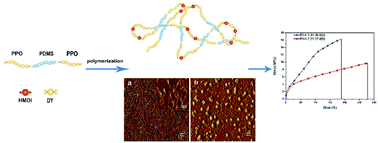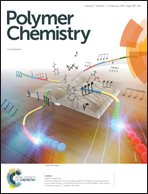Design and preparation of a new polyurea–polysiloxane–polyether copolymer with a block soft segment prepared by utilizing aza-Michael addition reaction
Abstract
A new synthesis strategy was presented to prepare a polyurea–polysiloxane–polyether copolymer (PUA). A new block soft segment (b-SS) was synthesised via an aza-Michael addition reaction of acryloxymethyl-terminated polydimethylsiloxane (AT-PDMS) and amine-terminated polyoxypropylene (PPO). The hard segment (HS) was formed from bis(4-isocyanato cyclohexyl)methane (HMDI) and a 2-methyl-1,5-diaminopentane chain extender. The copolymers are tough and easily processed thermoplastic elastomers. The properties and structures of the polyurea–polysiloxane–polyether copolymers were investigated by dynamic mechanic analysis (DMA), small angle X-ray scattering (SAXS), atomic force microscopy (AFM) and macroscopy mechanical testing. The DMA results of the polyurea–polysiloxane–polyether copolymers show that temperature insensitive rubbery plateaus exist between −50 °C and 80 °C, which are independent of the HS wt% and the molecular weight of PDMS. The viscoelastic behavior of the polyurea–polysiloxane–polyether copolymers was correlated with the molecular weight of PDMS used for the b-SS. The polyurea–polysiloxane–polyether copolymers display improved mechanical strength (16 MPa) compared with the published results of PDMS-based siloxane-urea segmented copolymers (11–13 MPa). The studies reveal that the mild microphase separation between the hard and soft segments leads to improved mechanical strength of the polyurea–polysiloxane–polyether copolymers. In addition, for these copolymers, the introduction of b-SS is effective in avoiding a sharp phase separation assuming that the molecular weight of PDMS in the b-SS is appropriate.



 Please wait while we load your content...
Please wait while we load your content...